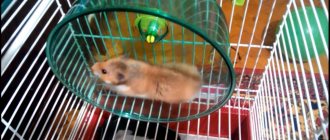- Symptoms of torpor in hamsters
If you decide to get a new family member, namely a hamster, you need to get acquainted with the life cycles of a small pet. It is especially important to know about the sleeping and waking patterns of a small creature. After all, sometimes it happens that the animal suddenly becomes numb, and it is not clear whether the homa has died or is sleeping. Information about how much hamsters sleep and what time of day is best to play with them is also important.
How long do hamsters sleep per day?
A small rodent can sleep up to 10 hours a day. These cute animals sleep during the day to protect themselves from possible dangers that may lurk at night. Moreover, each animal independently selects its own time to sleep: one goes to bed at 7 am, and the other can fall asleep at 9 o’clock .
ATTENTION! The duration of sleep is also affected by the age of the rodent. Young hamsters sleep from 6 to 8 hours, but old ones - from 18 to 20 hours.
The correct daily routine of an animal
Many breeders complain that the rodent sleeps for a very long time. We can say that a pet thinks the same about its owner, who sleeps at night. But what kind of regime do hamsters have?
Hamsters are nocturnal animals, but they have a routine, just like people. To understand the health status of your pet, just look at how much he sleeps. The norm for rodents is as follows:
- if a hamster sleeps 8 hours a day, then this indicates that he is very active;
- sleep at 10 o'clock indicates that the animal is in good physical and mental condition;
- if a hamster sleeps for 14 hours, it means you have acquired a lazy person;
- but if the duration of sleep is more than 14 hours, then not everything is in order with his health.
It is worth remembering one single rule: if the rodent is resting, then there is no need to touch it. You shouldn’t wake him up just to give him a treat or take him for a walk. Wait until the animal gets some sleep, and then have fun with it as much as you want. Teach him that after sleep he begins a period of special activity, games, food, self-care.
If the hamster doesn't get enough sleep, it may bite. It is also not recommended to try to create a regime for the animal that you like. This is not possible, because as mentioned above, the hamster is a nocturnal animal, and it will not be able to stay awake during the day. If he interferes with your sleep, simply place the cage in another room.
Why does my hamster sleep all the time?
Various changes can affect your pet's sleep. For example, if you moved the animal to another place or to another house, then it will behave differently.
There are two types of hamster behavior:
- Activity is the time when an animal is interested in everything that surrounds it. During this period, he can arrange his home. Adaptation of the animal to a new place takes place within 7 days. At this time he has no time to sleep .
- Sleep is a period when a hamster can sleep all day and leave its home only to eat and drink. During this period, the hamster can sleep up to 20 hours a day.
This is normal behavior for these animals and should not cause concern to the owner.
Illness can also be the cause of low activity.
How to tell if your furry is sick:
- He sleeps longer than usual and eats little.
- The animal stopped licking itself.
- Shows unusual aggression.
- Lethargic and having difficulty moving around the cage.
- Dull, matted fur, wet on the neck and chin.
- Discharge from eyes, nose.
- Wet tail.
- Changing the nature of the litter.
ATTENTION! If your pet sleeps for several days or more, then it is better to show it to a specialist.
Is it worth waking up the home?
If the hamster stops playing and sleeps all day, then he has gone into hibernation. There are two options here: either wake him up or let him sleep. What is the right thing to do? And here it all depends on the physiology of the hamster.
It is recommended to wake up your pet if he is numb from the cold. But this must be done according to the rules. You need to immediately warm the animal well; to do this, take it in your hands. Heating devices cannot be used for this.
Hold it in your hands and stroke it gently. You will notice how over a period of time his body will become warmer and his breathing will become more frequent. After which your pet will begin to slowly move, which means that he is waking up.
If the rodent fell into hibernation due to severe stress, then it is better to let it sleep well. How long his sleep will last depends on the degree of stress and the pet’s health.
Winter sleep of rodents
In the life of hamsters there are such concepts as torpor and winter sleep. Both of them have their own characteristics and duration. It is very important to distinguish between these two concepts so as not to harm your pet.
Torpor occurs when the days become shorter and the nights become longer. The hamster's body does not immediately adapt to this phenomenon. Therefore, if your hamster’s body has not yet adjusted, then he may experience torpor .
IMPORTANT! Well, confuse hibernation with torpor. During torpor, the reaction to stimuli disappears, body temperature decreases and all body processes slow down. It lasts several hours.
Your pet's prolonged sleep may indicate that he lives in unfavorable living conditions. It is at such a moment that so-called hibernation occurs.
Hibernation occurs when the temperature in the room where the hamster lives sharply drops. Anticipating the onset of cold weather, the animal falls asleep for several days. During hibernation, the baby's heartbeat and breathing slow down. With the onset of warming, the animal will wake up on its own.
Signs of hibernation:
- Slow heartbeat, sometimes it may not be heard at all.
- Decreased body temperature.
- The muscles become stiff.
The rhythm of life of wild animals
Once again, to understand the life cycles of hamsters, let's turn to the wild. All new owners are concerned about the question: do hamsters hibernate? And what kind of life do they generally lead?
Hibernation
The rhythm of life of wild rodents is quite simple: in the warm season, crunchies fill their cheeks and carry reserves in them to their burrow. They are preparing for unfavorable conditions - lower temperatures and lack of food in the meadows and vegetable gardens.
When the average daily temperature outside drops and the day becomes very short, the homa understands that it is time to get some sleep. After all, maintaining body temperature at a constant level during cold weather requires a large amount of food. But the hamster is an economical animal. If he eats up his reserves while trying to stay awake, he won’t survive the winter. Therefore, the homa goes into a hole, makes a nest of dry leaves and falls asleep not far from the pantry.
A sleeping hamster begins to breathe less frequently, its heartbeat also slows down, and its metabolism seems to adjust to an economical mode. At the same time, his body temperature becomes lower by 1-2ºС, which also saves energy resources for heating. The body is nourished during hibernation by the fat layer that the crunch has gained over the summer. Periodically, the homa wakes up, snacks on supplies and falls into torpor again.
With the spring temperature rise, rodents come out of their stupor and continue to eat up reserves, because there are still a couple of months before fresh food ripens.
Daytime nap
People don't often see hamsters in the wild because they are nocturnal animals. Khoma has no time to sleep at night, because under the cover of darkness he obtains supplies. Darkness is his faithful protector from predators and gardeners trying to catch the animal.
Tired during a working night, after dawn the homa hides in its hole, has a snack and goes to bed until the next evening. Likewise, the domestic hamster sleeps when people are active, and wakes up in the evening.
Why did the hamster hibernate?
The reasons for hibernation may be:
- excessive attention to the hamster from children or other pets, as a result of which the hamster becomes stressed;
- improper nutrition, due to which an imbalance of the protein-energy component occurs and the animal simply does not have the strength to stay awake;
- lack of light in the room;
- low temperature in the room where the animal is kept;
- improperly equipped housing - there are no toys, thanks to which the hamster receives a boost of energy and receives the necessary physical activity.
Diurnal or nocturnal animal
In the wild, representatives of the hamster family are nocturnal animals. During the day they sleep. These habits have also been preserved in domestic pets.
Is it possible to wake up a pet during the day?
Waking rodents during the day is prohibited. Attempts by the owners to change the animal’s regime will become a great stress for it, will lead to the development of pathologies, and will negatively affect life expectancy. It is better to let the hamster sleep. An awakened pet becomes aggressive and irritable. It can bite its owner if he reaches out his hand.
Why does a hamster sleep all the time?
The reason why a hamster constantly sleeps may be a change of residence or a move. During the first week, the animal hardly rests, as it actively explores the new territory and arranges its home. Then the adaptation is completed, the pet needs to relax. During this period, sleep can be up to 20 hours daily. The rodent leaves the house only for food or water. This behavior is normal and does not require intervention from the owners.
The hamster sleeps constantly due to a change of residence.
Inactivity is also possible due to illness. Take your pet to a veterinarian if the following symptoms are observed:
- sleep for 20 hours a day or more;
- lethargy, lack of interest in toys, communication with owners;
- loss of appetite to complete absence;
- aggressive behavior;
- weakness, difficulty moving around the cage;
- discharge from the nose or eyes;
- dull, matted fur;
- wet tail;
- wet fur on the chin, neck;
- lack of washing, licking;
- stool disorders, changes in the appearance or consistency of droppings.
Timely treatment will help save the animal.
Teaching your hamster to sleep at night
In a recent article, we persuaded a pet hamster to be quieter at night when he is so sleepy. Today we will not adapt to the nocturnal lifestyle of these animals, but will urgently ask them to maintain a more familiar routine for us: sleep at night and stay awake during the day. We hope none of the family will mind! The chances of success are small, but they are there.
Start by establishing a strong and friendly relationship with your pet. Get him used to your hands, in particular, feed him by hand. Play with your hamster as often as possible. Do everything so that the animal gets used to it as soon as possible, becomes attached to its owners and looks forward to each new meeting. What is all this for? So that changes in the hamster’s daily routine are smooth and not stressful.
Choose one of the rooms that has blinds or blackout curtains to darken the room. As you guessed, we will deceive the animal, trying to convince it that day is night, and night is day. If there is no dark room, you can simply cover the cage with a blanket or blanket, put the cage in a dark closet, etc.
Establish a “mirror” daily routine for your pet, exactly the opposite of the one that was in effect quite recently. First, develop a schedule that works for you, and then stick to it strictly. Play, feed, entertain your hamster strictly at the same time. Of course, control the onset of “day” and “night”: accordingly, either turn on the light or plunge the cage into darkness. Remember: all operations must be performed strictly at the same time, otherwise the vigilant animal will not be misled.
Your best friends are consistency and patience. The whole process of changing day to night and vice versa can last for several months. All this time, stick to the chosen schedule: interact, play, pick up, arrange games outside the cage, etc. Just be sure to make sure that natural daylight does not fall on the hamster during activities and games. Otherwise, all your attempts will be doomed to failure.
Source
How to take care of hamsters: daily care
Feeding
The hamster is fed 1-2 times a day, usually in the evening. The basis of the diet is dry food, but it is very important that the pet also receives succulent and protein foods. You should carefully study the list of prohibited and permitted products, otherwise the animal may suffer from indigestion or even die.
Children are often entrusted with taking care of hamsters: watching them during meals is very interesting. Small pieces of vegetables and fruits can be prepared in advance.
Pet stores have a wide selection of treats for rodents, but it is better to choose ones that are not sweet, without honey and other substances harmful to the hamster. Dried dandelion roots and millet spikelets are an excellent option for grinding down ever-growing incisors.
The pet is provided with fresh drinking water. Even in a closed automatic drinker, it is recommended to change the water every day.
Keeping it clean
Many people are interested in how to care for hamsters so that the cage does not have an unpleasant odor. To keep your pet healthy and not too “fragrant”, it is very important to monitor cleanliness. Every day, food residues that could go bad are removed - rotting fruit or stale meat is dangerous for the owner of the pantry.
The bottom of the cage should be generously covered with filler. Sawdust was previously used, but now corn and cellulose fillers are the most popular. The litter not only absorbs urine, but also allows the animal to dig and make hiding places.
You need to clean up after your hamster every day, removing wet litter and replacing it with fresh litter. The animals are clean and most often relieve themselves in the same place (“toilet corner”). And general cleaning with a complete replacement of the filler and washing the cage is not required so often: 3-4 times a month. Excessive zeal in this matter will lead to a nervous breakdown in the hamster.
Reproduction
Breeding enthusiasts are breeding hamsters at home. The fertility of these representatives of rodents is quite high, which allows them to bear numerous offspring regardless of the time of year.
A female hamster can become pregnant again the very next day after giving birth, and the ability to reproduce develops in young individuals as early as one and a half months. Optimally, the first mating of a female should be carried out during her age from 4 to 6 months, and the second mating should be carried out at 8 months.
Males reach reproductive age from 5 weeks and maintain it throughout their lives. The mating process takes no more than half an hour, and the duration of gestation for the female is from 15 to 20 days.
Description of Syrian hamsters
Syrians are the largest breed of domestic hamster. They have a large, knitted body and a short tail, round ears and bulging eyes.
Coat color and length
The most common animals are golden in color, but breeders have bred pets with other skin colors, such as:
The length and texture of the coat varies depending on the breed. There are long- and short-haired, satin and shaggy hamsters. There is also a bald variety.
Honey hamster.
Length and weight
The length of the rodent is 12-1.3 cm, of which 1.5 cm is on the tail. Weight - 100-125 g for males and 115-140 for females. There are large individuals weighing up to 200 g. This is the result of both obesity and the naturally strong physique of the individual.
Character and lifestyle
Each Syrian has an individual character and habits. In most cases, hamsters are friendly, but there are also aggressive individuals, especially among females.
Rodents willingly make contact and are easily tamed, but do not tolerate being in the vicinity of other animals, especially their own kind. Therefore, you need to keep one individual in a cage.
In nature, Syrians live in the steppes and are nocturnal. They are active and mobile, spend most of their time searching for food, and during the day they sleep in homemade nests or natural shelters.
Lifespan
Hamsters live on average 2-3 years in the wild and 3-4 years in captivity. The record is 6.5 years.
Sleep standards
For a comfortable rest, the sleep norm is 6–10 hours a day. Nature has carefully thought out everything, so hamsters sleep during the day and are awake at night.
Djungarian hamsters, which are most often kept as pets, can go to bed at 8 am, or even at 10 am. Each individual chooses a comfortable rest time. Some sleepyheads can sleep 14 hours a day. You shouldn’t be surprised by this behavior, because everyone has their own body and needs.
Reference. As a result of the stress they have suffered, some rodents can sleep 20 hours a day, this is how they regain strength.
Hamsters, just like people, are highly dependent on changes in their lives. For example, when moving, they also get unnecessarily tired. There are two main lines of behavior for a pet when moving to a new place of residence:
- Active state. In this case, the pet studies everything that surrounds it, runs and frolics. He tries to study everything and make it as comfortable as possible for himself, in which case he has very little time left for sleep, about 3–5 hours a day.
- Dream. The animal constantly tries to hide from prying eyes, leaving the house only when it wants to eat or go to the toilet. The pet sleeps for almost 20 hours a day; getting used to it can take up to one week.
Ensuring activity
Keeping hamsters in tiny cages or a three-liter jar is cruel to the animal, which in nature runs several kilometers every day. It’s not for nothing that their home is equipped with a running wheel. Caring for hamsters may include providing them with leisure time. The owners set up entire playgrounds, labyrinths and tunnels for curious rodents.
Despite the need for movement and variety, you can only let your pet out for a walk around the apartment in a walking ball. Otherwise, the hamster at home is in mortal danger - it can get stuck, be crushed/pinched by a door, fall, fall into a pan, eat a poisonous plant, or chew through an electric wire. Catching a pet can be very difficult.
You cannot organize a walk on high surfaces (table, sofa). All hamsters come from the lowland steppes; they do not understand and are not afraid of heights. There is a high risk that the pet will fall.
Is it possible to walk a hamster outside?
With the best of intentions, some owners strive to let their pet spend time in nature. But the pet hamster will not receive pleasure from such a walk, but extreme stress. Not many people think about the fact that a pet can become seriously ill.
In nature, the animal is in wait for predators: dogs, cats, rats, crows. A nimble baby can easily run away and get lost forever. The outdoor environment is more aggressive and unstable: the hamster can become hypothermic, especially if the grass is wet, or overheat in the sun. The soil and grass are often infested with parasites and are a source of infection due to wild rodents.
How to care for newborn hamsters?
The baby hamsters that are born are very small in size, but they are under the reliable protection of their mother. The main task of the owner in this case is not to harm the emerging offspring.
Basic rules for caring for newborn hamsters:
- A soft straw should be placed at the bottom of the cage with the babies and the female; any other filler can damage the delicate skin of newborns.
- The cage should have a drinking bowl and feeder for the female, and toys should be removed for a while.
- Under no circumstances should you touch newborn hamsters, but it is important to monitor the female’s nutrition, adding special vitamins to her food each time.
- Complementary feeding should be introduced when small hamsters grow a little and begin to become covered with fur. Cabbage leaves serve as the basis for complementary feeding, and from one month on, boiled chicken can be introduced into the baby’s diet.
You can move a mother and her children when they reach the age of one and a half months.
Hamsters in a cage
Hibernation and torpor
During the cold season, hamsters hibernate. This phenomenon occurs when the environment becomes unfavorable for life. At home, rodents fall asleep for several days when the room where they live becomes cold. At the same time, the heartbeat and breathing slow down, the body temperature decreases, and the muscles harden.
What breeds are susceptible to hibernation?
Hamsters can hibernate:
- Syrian;
- Dzungarian;
- long-tailed;
- ordinary;
- Angora;
- albinos.
Various breeds of hamsters hibernate.
Symptoms of numbness
Torpor develops when the hamster’s body does not have time to adjust to the change in daylight hours. The animal remains in this state for only a few hours.
Numbness can be recognized by a number of signs:
- body temperature decreases;
- there is no reaction to external stimuli;
- the muscles harden;
- Pulse and breathing slow down greatly.
What can cause a hamster to hibernate at home?
At home, hibernation is caused by a number of reasons:
- Excessive attention to the hamster. If small children or other pets actively play with a rodent and are constantly near the cage, the pet experiences severe stress. Anabiosis helps to survive nervous tension.
- Incorrectly formulated diet. If an animal lacks proteins or carbohydrates, during the day he will be weak and lethargic due to lack of strength. There is not enough energy for activity, so the rodent begins to sleep a lot. The cause may also be a lack of vitamins or microelements.
- Low room illumination. Instinctively, hamsters perceive the shortening of daylight hours as the arrival of autumn, the approach of cold weather. To avoid the onset of suspended animation, open the curtains in the morning in the room where the pet lives.
- Low temperature in the room where the cage is located. If the room does not become warmer than +15°C for a long time, the likelihood of suspended animation greatly increases. At +10°C a similar phenomenon will definitely occur.
- Unsuitable conditions of detention. In the absence of toys, the hamster does not receive a boost of energy or regular physical activity.
A hamster may hibernate due to excessive attention.
Duration of hibernation
The duration of hibernation depends on the reasons that caused it and the individual characteristics of the animal. Normally, at home, suspended animation lasts for several days, after which the hamster returns to its previous rhythm of life.
Should you bring your pet out of hibernation?
Veterinarians have differing opinions. Some experts argue that rodents cannot be brought out of hibernation on purpose. Doctors believe that processes in the body should occur naturally. Individuals falling into suspended animation live on average longer than those avoiding hibernation.
Other veterinarians say that you need to wake up your hamster. At home, a rodent has no need to save strength or energy during the cold season.
Hibernation only disrupts the regime. In addition, females who fall into suspended animation give birth to cubs less frequently and in smaller numbers.
How to wake up
To make a sleepy hamster wake up faster, warm it up. Move your pet in your arms to a warm room. To increase body temperature faster, place a heating pad or a bottle filled with hot water next to the animal. Be sure to place a folded towel in several layers between the heat source and the rodent. You can warm your pet with your body and gently rub its back.
When the rodent begins to show signs of life, try to give it something to drink. To do this, you can use a syringe without a needle or a pipette. If an animal swallows or tries to lick a drop, it begins to wake up. You can speed up awakening with a sugar solution. To do this, dilute 1 tsp. sugar in 1 tbsp. water at room temperature, then offer it to the hamster. Glucose will help restore strength faster and provoke your pet to be active.











